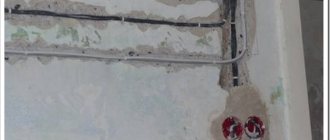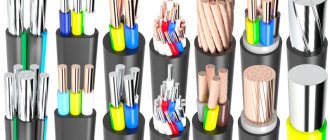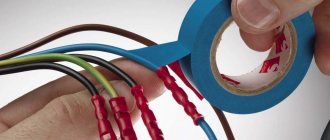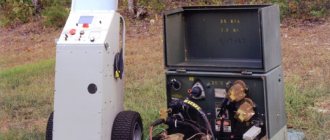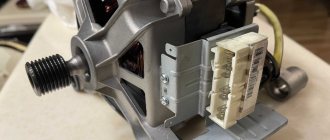An electrical network is a system of connecting electrical installations among which energy is transmitted and distributed.
During operation of any system, errors and malfunctions may occur: for example, overloads, voltage surges, and current leakage.
Let's look at the causes of errors and malfunctions in electrical installations and talk about what methods are available to prevent possible failures and breakdowns.
ACCEPTANCE OF ELECTRICAL EQUIPMENT WHEN PREPARING A CAR FOR A VOYAGE
Car conductors are required to know well the purpose of all electrical equipment of the car and be able to use them correctly. Along with all the workers associated with the inspection and preparation of a passenger car for a trip, mechanics-foremen and car conductors are also responsible for sending a faulty car with the train. When accepting a carriage, the conductor is obliged to thoroughly check all electrical equipment. Check the inspection period for electrical equipment using the stencil on the end wall of the car (the inspection is performed after 6 months). Check the condition of the undercar generator drive. When using a belt drive, you must make sure that the belt is sewn correctly and does not have tears or delaminations. If the belt is lengthened, it must be altered so that when the belt is on, the generator is tilted towards the pulley by 15°. In winter, when frozen, the weft cord fabric belt must be removed, dried and put on again. With a gear-cardan drive, you need to pay attention to the fastening of the gearbox, propeller shaft, safety brackets and make sure that there is no leakage of lubricant from the gearbox, and also check the inspection period of the gearbox using a stencil on a metal tag attached to the axle box (the gearbox is inspected after 6 months). In order to correctly determine the condition of the battery, the mechanic-foreman, train electrician and car conductors must know what type of battery is installed in the cars being received. The battery voltage is checked under full load. At a voltage equal to or less than that specified in the table. 20, you must immediately charge the battery or turn it off. Table 20 The conductor must inspect all fuses; In terms of current, they must correspond to their purpose. The presence of non-standard fuses (bugs) is not allowed. Check that all electrical consumers are in working order: forced ventilation, circulation pumps, refrigeration units, electric boiler, electric water-filling head heaters, bell alarms, lighting networks (incandescent and fluorescent lamps). Check the condition of signal tail and landing lights, hanging landing lights, table lamps, inspect soffit lights and check for foreign objects. At the same time, the serviceability of switches and switches is checked and, in accessible places, the reliability of terminal connections, fastening of electrical panels and protective covers. The car conductor is obliged to inform the mechanic-foreman and the train electrician about all noticed malfunctions in the accepted car. It is strictly forbidden to send a car on a trip with faulty electrical equipment, a discharged battery, without a drive belt, with a faulty gear-universal drive of the generator, as well as with electric mains connected between the car connections.
Replacing car wiring
When replacing wiring in a car, be sure to turn off the power, including disconnecting the battery. Of course, this is not a precaution against electric shock, but protection of the vehicle’s electrical equipment from possible short circuits that may occur during repair work.
Sometimes the replacement can be completed in 10-15 minutes - for example, if the wires of the “battery-generator” supply circuit are damaged. If the integrity of the wiring in the cabin is damaged, there are problems with grounding, or a short circuit in the on-board computer circuit, then the work will take much more time. And the main thing here is not to make a mistake, since incorrectly connecting the wires (for example, if the polarity is reversed) can cause a short circuit, damage to expensive electrical equipment and even a fire. If you do not have experience in electrical engineering and electrical installation work, it is better to contact a specialized service for the services of a professional auto electrician.
You can download the diagrams from here.
Before we get started, let's get acquainted with the basic principles of these schemes:
1. There are three main lines. The top red one is a conditionally constant “+” from the battery (we can say that these are two wires that go into the passenger compartment and to the starter/generator from the battery advisory terminal). The black under the aforementioned red is the “+”, from the ignition switch, which powers consumers when the key is turned to the recommended position. The bottom black one is a conditionally constant “-”, which is also the mass (car body).
2. At the bottom of the diagram you can see the labels of the electrical equipment groups in the wiring. The groups are in order of importance, i.e. start with engine systems and end with auxiliary devices. Many groups are “intertwined” with each other physically, but are placed far from each other on the diagrams. In this case, the corresponding wires on the diagrams have at their ends a designation of the coordinate where it is transferred - references. This is a rectangle with numbers in green fill.
MAINTENANCE AND MONITORING OF ELECTRICAL EQUIPMENT DURING THE TRAIN’S PATH
Only conductors who know the purpose of all its devices, know how to use them correctly, and have passed the exam are allowed to service electrical equipment. During the train's journey, the electrical equipment of the carriage must be under constant supervision. The conductor on duty is strictly prohibited from leaving the carriage while the train is moving. The car conductor is obliged to: after leaving the formation station, check the operation of the electric boiler and drinking water cooler, which operate only when the under-car generator is turned on; monitor the good condition and operation of the electrical equipment of the car, the readings of the voltmeter and ammeter, and also check the degree of heating of electrical equipment in accessible places (their temperature should not exceed 50-60 C), without touching the current-carrying contacts. If the needles of the measuring instruments oscillate or deviate all the way towards the maximum readings, it is necessary to turn off the generator and report the incident to the train electrician or foreman. It must be remembered that blinking, bright glow or destruction of glass bulbs of light bulbs, deviation of instrument needles to the end of the scale, heating of fuse housings, switches and other electrical equipment are necessarily a sign of one or another serious malfunction. Blown fuses must be replaced by a train electrician. If they burn out again, you must immediately inform the mechanic-foreman about the incident, find out the cause and take measures to eliminate the malfunction. If the drive belt is lost, the gear drive is damaged, or the generator fails, it is allowed to connect to the power supply from a neighboring car with working equipment. At the same time, only carriage lighting is provided with a mandatory reduction in operating lamps to 50% in both the carriage consuming and the carriage supplying electricity. All other current consumers must be switched off. When powered from a neighboring car, in order to prevent excessive discharge of the battery, it is recommended to remove its fuse on the panel. The supply of current to the adjacent car (reception of current to the car being serviced) is controlled by the main ammeter, which has a red mark at the number 30 A. Current of more than 30 A is not allowed to be supplied to the adjacent car. To supply current to an adjacent car built by domestic factories, it is necessary to set the line packet switch to the “On” position, and the switch to the upper position; To receive current from a neighboring car, you need to set the main line packet switch to the “On” position and move the switch to the lower position. In cars built by factories of the GDR, Hungary and Poland, the main switch in the car supplying current should be set to the “Supply” position, and in the car receiving power from the neighboring one, to the “From main” position. When connecting electric mains in cars with an alternating current generator, set it in the car supplying current to the “Supply” position, and in the car connected to it, to the “From main” position. While the train is moving, it is necessary to monitor the readings of the voltmeter and ammeter. When the generator is running, the voltmeter should show the battery charging voltage within 54-65 V for the Gazelan generator and 54-70 V for the RD-2D generator. If the ammeter and voltmeter do not indicate battery charging, you need to check the condition of the belt or gear-cardan drive at the first stop. If they malfunction, you must immediately notify the train electrician or foreman and that the battery is being charged. During the route, periodically by pressing the corresponding button on the switchboard, check whether there is a short to ground of the positive or negative wire of the car. Checking for a short circuit cannot be performed when the water tank filling alarm is on, or when the undercar line is energized. If damage to the wire insulation is detected, you must immediately stop powering the car and call a mechanic-foreman or train electrician to identify and eliminate the problem. The car conductor needs to check the heating of the fuses by hand by touch when the current consumers are switched on. If the fuse gets hot, it should be tightened. At the final stations, when leaving the car, it is recommended to turn off all electricity consumers - set all package switches to the “Off” position. Maintenance personnel of modern passenger cars must provide technically competent maintenance of electrical equipment. Strictly follow fire safety rules, know where in the electrical system damage is possible from shaking, vibration, etc. A special danger of fire is created when electrical equipment is used incorrectly and there are faults in the power supply system. A short circuit due to damaged insulation in electrical wiring and electrical equipment most often occurs: in places where wires are fastened with metal brackets to walls without additional insulation; in places where wires exit metal pipes without installing additional insulating bushings; in places where wires pass through holes in metal partitions without additional insulation; in places where wires touch and rub against metal parts of package switches, bell dialers, protective covers, etc. Short circuits can also occur due to: heating of various resistances (regulating, damping, dimming) and heating devices; moisture getting on the wires, especially where they enter the car; loosening of contacts and touching of adjacent wires with tips (especially on terminal strips behind shields), as well as shorting of contacts with foreign metal objects. Dangerous overloading of electrical equipment can occur when electricity is supplied to the main line to power another car without limiting power consumption or when electric heating devices - irons, stoves, etc. - are connected to the network. Passenger car conductors need to know that in the event of a short circuit, the wires instantly heat up and melt, and the insulation of the wires and nearby flammable materials or objects ignite. When overloaded, the electrical wires gradually heat up, a characteristic smell of burning rubber and fabric appears, the insulation is destroyed and a short circuit occurs. Loose contacts cause local heating of terminals, fuses, and packet switches, and a characteristic burnout margin appears. If timely measures are not taken to eliminate the cause of the heating, the insulation of the wires and even the panels themselves may catch fire or a short circuit may occur. When the train is stopped, there are cases when the reverse current relay of the stabilizer regulator does not work, as a result of which current flows in the opposite direction from the battery to the generator (a sign of this is the hum of the machine). In such cases, you should immediately remove the fuse on the distribution board and report it to the foreman or electrician so that appropriate measures can be taken. If smoke appears in the carriage from the boiler or titanium furnace, the carriage conductor is obliged to immediately notify the train foreman about this and at the same time check the serviceability of the smoke exhaust pipes, find out the cause of the appearance of smoke in the carriage and take measures to eliminate it. In this case, it is necessary to make sure that there are no fires between the ceiling and the roof of the car, especially in places adjacent to boiler installations, above electrical equipment in the service room, in ventilation ducts, and in places where stabilizers are installed. If a characteristic smell of burning rubber, fabric or other suspicious odor appears in a carriage, it is necessary to immediately find out the reason for its appearance, for which purpose inspect the service area, check the degree of heating of electrical equipment, inspect the boiler room and other premises. Immediately report the incident to the train foreman. It is impossible to leave the causes of malfunctions unclear and unresolved. It is prohibited to turn on the voltage if there are faults in individual elements of electrical equipment and if there is unacceptable heating of electrical appliances on the distribution board. Switchboards, electrical appliances and equipment should be kept clean at all times. In addition, carriage conductors should not allow unauthorized persons into the service compartment. If electrical wires or electrical equipment catch fire, you must first stop the train and turn off all electricity consumers, except for the lighting network at night. It is prohibited to stop the train on railway bridges, overpasses, in tunnels, under bridges, overpasses and in other places that impede the evacuation of passengers and the organization of fire extinguishing.
- << Back
- Forward >>
Car electrical wiring repair
You can check and restore the car's electrical wiring yourself or at a car service center. After identifying faulty areas where there is damage to the wires, a short circuit or a break, they are soldered or completely replaced. Conventional twisting followed by crimping is not a full-fledged repair, but only a temporary measure - take this into account if you do not have the opportunity to solder the break points.
Wires are selected with the same characteristics as the existing damaged ones (resistance, metal). You should not install too long wires with a “reserve”; twisted open wiring under the influence of negative factors (temperature changes, moisture, dirt) is destroyed faster - this can lead to a short circuit. When replacing wiring harnesses with connectors, make sure that the contact groups are completely free of oxidation before work.
Mounting blocks located in the engine compartment are also considered a vulnerable element of a car's electrical system. Due to the destructive effects of temperature and moisture changes, damage to the protective coating and subsequent defects in tracks, connectors for connecting wiring harnesses, relays, and capacitors are possible. Repair of mounting blocks, consisting of circuit boards, fuses and electrical components, includes soldering to restore tracks and coating with a special protective varnish, as well as replacement of faulty elements and wiring, connectors, cleaning contact groups from dirt and oxidation.
Suspension bushings and brake lines
As has been discussed many times before, one worn component can affect the longevity of more expensive components and assemblies, and can also lead to costly breakdowns and even accidents. A worn bushing in a car suspension, the cost of which does not exceed 1500-3000 rubles. may cause deterioration in controllability, which puts your life and health at risk, especially in a critical situation. This danger can occur no matter what driving style you prefer.
In addition to the potential danger, this also leads to a decrease in vibration-acoustic comfort, so driving with a loose suspension element will make driving an extremely unpleasant experience.
The same applies to brake and fuel lines. If the latter are made of metal alloys that guarantee many years of operation, then brake pipes require constant attention and timely replacement. Even a small leak can lead to the failure of a much-needed system, which will provoke a serious accident, so saving on replacing such elements is extremely unjustified.
A brake hose, regardless of the cost of the car brand, rarely costs more than 2,000 rubles, which is not a big price to pay for the safety of you and your loved ones.
Always check with the service center whether the system has been diagnosed during routine maintenance. Also, test your brakes in a deserted area and at low speeds to help identify potential problems.
Remember that constant monitoring of the occurrence of extraneous noises, creaks, odors or knocks will allow you to promptly identify a breakdown and save on possible consequences. Any suspicions you may have should be discussed in detail with a qualified mechanic. At the same time, it is also necessary to describe the situation in which extraneous noises arise or odors appear, in particular the degree of engine warm-up, driving speed or weather conditions, which will help preserve not only your car, but also your health.
ECM malfunctions
The electronic engine control system, or ECM for short, also sometimes breaks down. Being connected to a diesel engine, it can be susceptible to faults such as wiring breaks and loss of communication with sensors. If you have a gasoline internal combustion engine, this list will look like this:
- up to 35% of breakdowns in this case occur due to wire breaks and loss of communication between sensors and the electronic control unit;
- up to 22% – problems with the fuel pump: jamming of the armature and brushes, contacts between the turns of the winding or its breakage;
- up to 9% – malfunctions associated with the electromagnetic injector wires: breakdowns, breaks, unnecessary contacts.
A good help for the vehicle owner is the vehicle’s self-diagnosis system, which records and stores information about possible malfunctions in the operation of the vehicle. With some of them, the “Check engine” indicator lights up.
The fault codes recorded by the system are read using a laptop connected to the car with a scanner or directly. A smartphone is also applicable.
The circuit breaker switches off with a time delay
You can determine that the machine has switched off due to overload by two signs:
- At the moment the protection was triggered, no household electrical appliances were detected.
- It is impossible to turn on the machine immediately after triggering - it does not latch until the bimetallic plate of the thermal release has cooled down.
After allowing the machine to cool, we prepare a current clamp or a multimeter that contains them. We open the panel with the circuit breaker and prepare to measure the current at its output. To do this, you will need to bend the wire so that it is wrapped around the magnetic circuit of the clamps.
We turn on the machine and measure the current. If its value exceeds the rated protection current, then you will have to look for the cause of the overload. If the current is below the rated current, and the machine turns off again after a while, it means it is faulty.
To find the cause of the overload, the same multimeter or clamps are used. By alternately disconnecting household appliances from the network and turning on the machine for a short time, the current is measured. The difference between the previous measured value and the current one will give the current consumed by the disconnected network element.
If an electrical appliance consumes power above its rated value, this indicates a malfunction. If the energy consumption of all devices is normal, and after they are all disconnected from the network, the current is zero, then you either need to not turn them all on at the same time, or for the most powerful of them, provide personal sockets protected by their own circuit breaker. They will have to install new electrical wiring from the distribution panel.
Rated current of the circuit breaker If all electrical appliances from the network are turned off, and the protection still trips, you will have to look for the fault directly in the wiring.
Battery faults
The battery contains six containers that generate voltage, two volts each. Over time, the plates in these vessels begin to crumble, the battery capacity decreases, and the unit sometimes stops charging altogether. Basically, battery problems manifest themselves in the following:
- rapid depreciation of the battery due to under- or overcharging, which may be a consequence of improper operation of the voltage regulator;
- self-discharge of the battery due to a decrease in the amount of active mass inside it;
- oxidation of contacts, which can cause a break in the electrical circuit between the battery and other vehicle equipment;
- Damage to the battery crankcase through which electrolyte leaks.
When checking the health of a battery, a multimeter is usually used. In addition, a hydrometer determines the density of the electrolyte in the containers, and using a load plug, the ability of the battery to operate with a connected energy consumer is determined.
Rules for self-diagnosis
To avoid mistakes when diagnosing a car yourself, you need to check everything carefully. To identify a fault group, be sure to remember the main symptoms of a breakdown - knocking, extraneous vibrations, blinking lamps, difficulty in controlling the machine, and others. During the diagnostic process, you need to use the following set of rules:
- Check from simple to complex. There is no denying the obvious causes of breakdowns or symptoms.
- If the fuse is blown, then electrical diagnostics are required, as this indicates problems with the devices on this contact.
- When a part fails, it must either be repaired or replaced, as the failure often gets worse.
Even minor car breakdowns can lead to an emergency on the road. The machine's lights and electrical systems should function properly, as should the controls. If problems are found with the auto electrics, brakes or steering system, then be sure to diagnose and fix the problem. If you can’t figure it out on your own, it’s better to contact a car service center.
Checking the glass heating filaments
If, after a detailed check, we find no problems with the wiring, we proceed to check and repair the heating element itself.
- We start the engine and turn on the heater.
- We sequentially measure the voltage of each of the conductive strips by placing one multimeter probe on ground, and the second on the strip at different distances from the center of the glass.
- If the voltage on the strip is the same at any point, regardless of the distance from the positive bus, check the contact of the negative bus with the ground (body) of the car.
- If the heating element is working properly, the voltage should drop as the multimeter probe moves away from the positive busbar of the heater.
- A sudden lack of voltage on the strip will indicate a break in the conductive layer. As soon as we have fixed the cliff, we mark this place with a marker or any other way.
To repair a break, you can use conductive glue Kontaktol, but first you need to clean and degrease the damaged area, only then apply glue, and after it dries, cover the repaired area with colorless varnish. There are situations when the resistive strip breaks off from the bus itself. In this case, it can be soldered using a soldering iron with a power of up to 30-40 W and silver-containing solder (3%), and ordinary rosin paste can be used as a flux.
Problems with the ignition system
About 10-12% of car electrical faults relate to the ignition system. And in 80% of cases, such problems lead to an increase in fuel consumption by 5-6%, as well as a decrease in engine power, which can simply stall while driving. Which car owner would like this?
The most typical failure of the ignition system is the absence of a spark at the spark plug. But others are not excluded:
- violation of insulation of high-voltage wires;
- burnout of spark plug tips or the appearance of deposits on them;
- the appearance of plaque on the spark plug cone;
- damage to the spark plug insulator;
- open circuit in the 12-volt circuit supplying the breaker and the primary winding of the ignition coil.
The state of the ignition system can be judged by the operating parameters of its spark plugs or the primary voltage on the coil, to determine which an oscilloscope and a motor tester are used. Repair of this complex consists of replacing faulty parts and repairing damaged contacts.



